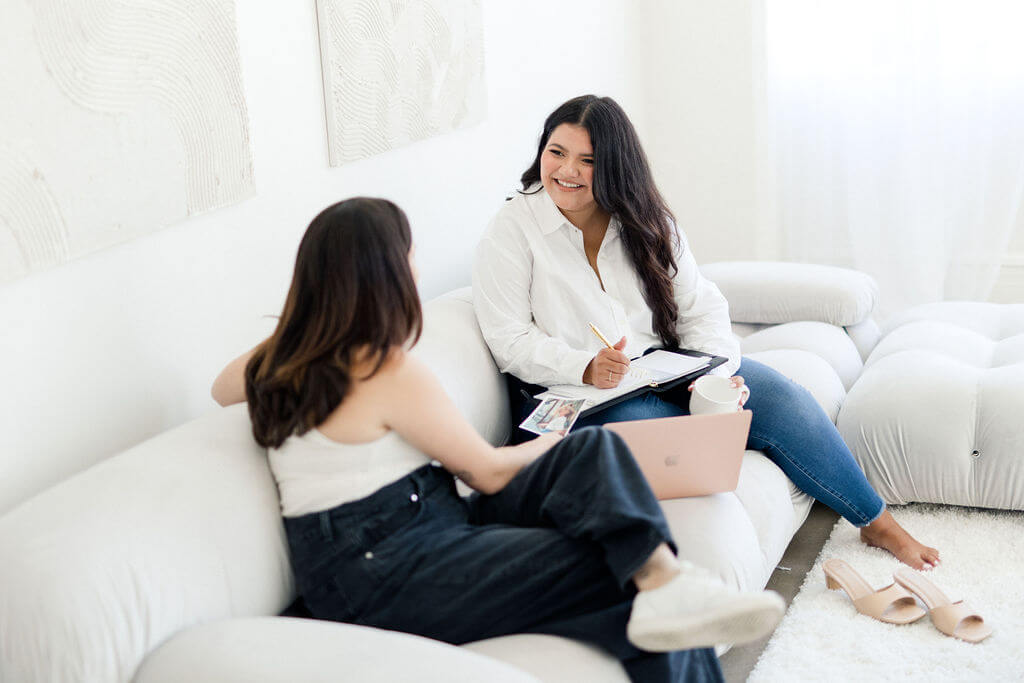As of Fall 2022, over 60% of all web traffic came from mobile devices. In this day and age, where more people access the internet via mobile devices than ever, it’s critical that your website is designed with mobile in mind. Desktop computers are no longer leading the way. So, whether you’re starting a new website or revamping your existing one, making it responsive should be top of mind.
In this blog post, we’ll discuss the advantages of responsive website design, best practices for developing a responsive website, and when it might be time to invest in a website designer. So pour yourself a cup of coffee and let’s get started!
What is responsive website design?
So, what exactly is responsive website design? Well, think of it as the little black dress of website design. It adapts and responds to different devices, so that your website looks just as good on a smartphone or tablet as it does on a laptop or desktop computer. Sort of like the way a little black dress adapts to whatever occasion you are dressing for.
Why is responsive website design important?
In today’s world, having a mobile-optimized website is a must for conversion and to keep visitors from bouncing from your website. You see, not only do mobile users expect a seamless experience on their devices, but search engines like Google also favor mobile-friendly websites in their search results. So, if you want to stay ahead of the competition and make a great first impression on potential customers, mobile optimization is key.

The Benefits of Responsive Design
Improved User Experience on Different Devices
First, let’s talk about why responsive design is a game-changer. For starters, it provides a fantastic user experience on different devices. No more frustration for your customers trying to navigate your website on their smartphones. With responsive design, your website adjusts to fit the device it’s being viewed on, providing a seamless experience for your customers.
Better Accessibility and Readability
Another benefit of responsive design is improved accessibility and readability. Your website will be easy to navigate and read, no matter what device it’s being viewed on. And let’s face it, we all appreciate a website that’s easy to use and is nice to look at.
Search Engine Optimization (SEO)
And last but certainly not least, responsive design can give your SEO a boost. As mentioned earlier, search engines like Google favor mobile-friendly websites, so having a responsive website can help improve your search engine rankings. And we all know, higher search engine rankings equal more visibility and more potential customers. So, it’s a win-win situation!
With these benefits as the reward, you’ll want responsive website design to be high on your list of priorities when creating or updating your website.

Overcoming the Challenges of Responsive Design
Complexity of Adapting to Different Screen Sizes
Ensuring your website design is responsive in not without its challenges. The first challenge is adapting to different screen sizes. With so many different devices and screen sizes out there, it can be a complex task to ensure your website looks great and functions well on all of them. This is one of the many reasons why I chose to specialize in Showit website design. Their drag-and-drop builder allows me to edit the mobile version of my clients’ websites while I design the desktop version. I have complete control over what the mobile version of my website looks like and I’m able to adjust any aspect that didn’t translate to mobile correctly.
Maintaining Consistency Across Devices
Another challenge is maintaining consistency across devices. You want your website to look and feel the same, no matter what device it’s being viewed on. This can be a delicate balance, as you want to take advantage of the unique features of each device while still keeping a consistent look and feel. While your mobile layout may need to be adjusted to fit a mobile screen size better, you will want to make sure it still aligns with the design of the desktop view.
Balancing Functionality and Aesthetics
And finally, there’s the challenge of balancing functionality and aesthetics. A responsive website must not only look great, but it must also be easy to use and navigate. Striking a balance between form and function can be a tricky task, but it’s essential to ensure the success of your website in the mobile-first era.
In conclusion, while there are challenges to overcome, the benefits of responsive design make it worth the effort.
Best Practices for Responsive Design
Design for Flexibility
When it comes to creating a responsive website, one of the best practices is to design for flexibility. This means designing with the understanding that your website will be viewed on a variety of devices and screen sizes, and that it should be able to adapt accordingly. My best tip for responsive website design is using a website builder that prioritizes it. I exclusively design Showit websites because I have not found another platform that makes it so easy to optimize the mobile layout of a website. (If you’re interested in trying out Showit for free, you can get your first month free here.)
Testing on Different Devices and Screen Sizes
It’s also important to test your website on different devices and screen sizes. This will give you the opportunity to see how it looks and functions in real-world conditions and make any necessary changes. I like to check a website on every possible device it might be viewed on: desktop, laptop, iPad, and mobile before launching it. The last thing you want is someone checking out your newly launched website and hearing that there was an issue with the mobile version of your website.
Maintaining Simplicity and Consistency
Finally, it’s essential to maintain simplicity and consistency in your responsive design. Your website should be easy to navigate and understand, regardless of the device being used. By keeping things simple and consistent, you’ll provide a better user experience for your visitors and help them take the action you want them to take on your website.
By following these best practices, you’ll be well on your way to creating a responsive website that looks great, functions well, and provides a positive user experience.

Why You May Want to Hire a Website Designer for Your Responsive Website Design Needs
You might be reading this and thinking, “Great! I definitely want to make sure my website is optimized for mobile but that sounds like a lot of work and I’d rather leave it to a professional”. This part of this blog post is for you. Before I wrap up this blog post, I want to touch on the importance of professional design, benefits of working with an expert, and tips for choosing the right website designer if that feels like the right route for you to take.
Importance of Professional Design and Development
When it comes to creating a responsive website, it’s important to invest in professional design and development. While there are many DIY options out there like website templates, working with an experienced website designer can ensure that your website is not only visually appealing and designed strategically, but also functional and optimized for different devices and screen sizes.
Benefits of Working with an Expert
There are many benefits to working with a website designer, including their expertise in design principles, user experience, and web development. A website designer can help you create a website that accurately reflects your brand and meets the needs of your target audience. Not to mention being able to craft your website to your goals for your business. Additionally, a website designer can provide guidance and support throughout the entire process, from planning to launch and beyond.
Tips for Choosing the Right Website Designer
When choosing a website designer, it’s important to consider several key factors, such as their experience, portfolio, and pricing.
Communication Style
You’ll want to look for a designer who communicates effectively, listens to your needs, and has a clear understanding of your goals for your website. You’re likely going to spend a considerable amount of time with them on your website design project, so you’ll want to make sure you get a feel for what working and communicating with them would be like to make sure you are compatible before working together. Don’t be afraid to ask about the designer’s process, timeline, and pricing. These are important things to know before you start working together.
Experience
Ideally, you’ll want your website designer to have experience in your industry or with business owners in your niche. Designing websites for online businesses is quite different than designing websites for brick and mortar businesses. Look at their portfolio to get a good idea of their design style and the type of businesses they have designed for. Be forthcoming with the vision you have for your website, share anything you’ve collected for design inspiration to help paint the picture of what you are hoping to achieve.
Working with a Website Designer vs Do-It-Yourself
Hiring a website designer for your responsive website design needs can be a valuable investment that pays off in the long run. With the right designer, you can create a website that not only looks great but also provides a seamless user experience for your visitors no matter what device they are on.
If you do take the DIY route, make sure to choose a website template that is designed for mobile optimization. The ones I recommend to friends and clients are Tonic Site Shop Showit website templates (save 15% on any purchase with code briarcroftlane15) and Saffron Avenue Showit website templates (save 10% on any purchase with code briarcroftlane). If you find a template you’re obsessed with but would still rather work with a designer to bring it to life, that is an option too! I offer template customization with my expedited service The Online Presence where we can customize your chosen template to your brand in under a week.

A Final Note
In a time where 60% of website traffic comes from mobile devices, responsive design has become more important than ever. Having a responsive website is crucial for providing a seamless user experience for your visitors. Not only does responsive design improve the user experience, but it also offers benefits such as better accessibility and readability, and better search engine optimization (SEO).
As a business owner, your website is an essential tool for growing your business and reaching your target audience. Embracing responsive website design can help you stay ahead of the competition and provide a better user experience for your visitors that makes them want to keep coming back. To get the most out of your website, consider working with a website designer who can help you create a website that is both visually appealing and functional or consider choosing a website template designed with mobile optimization in mind.
All in all, I encourage you to take the time to invest responsive design for your website and take advantage of all its benefits. Whether you’re starting a new website or revamping an existing one, responsive website design can help you create a website experience that is accessible, readable, and optimized for all devices and screen sizes. Don’t wait any longer to see the positive impacts responsive website design can have on your business.
Thank you for reading! I am so happy you’re here!
If we haven’t met yet, hello! I’m Christiana Nicole—founder of Briarcroft Lane Design Studio, Brand Strategist, and Showit Website Designer for creative entrepreneurs and intentional small business owners, like yourself!
If you want even more branding, website design, and business content and resources, here are a few ways that I can support you in your branding & website journey:
Subscribe to my newsletter! On Sundays, I send out my beloved weekly newsletter, Sunday Style & Strategy, featuring business, marketing, and design tips and resources you’ll actually use. Delivered straight to your inbox plus what we’re inspired by and obsessing over this week. Subscribe for actionable strategies, design inspiration, and business resources, every Sunday!
Read the Briarcroft Lane blog. The modern founder’s one-stop-shop for all things business, branding, and Showit website design. Need a recommendation on what to read next? If you liked this post, I think you’d enjoy How to Design a Website That Converts or The Power of Branding: How to Build a Memorable Brand.
Browse The Resource Edit. Over the years, I found myself recommending the same business tools, educators, and products to my clients over and over again. I wanted a place I could share everything that has supported me in my business with business friends like you. The Resource Edit is my library of free resources, business tools, favorite digital products, podcast and book recommendations, and my personal must-haves (for work and life). Don’t tell the others, but it might be my favorite page of my website!
Learn about how we can work together.
Using my background in design, marketing, and business, I break down brand strategy, branding, and website design into a collaborative and insightful process for female founders like you. A process that not only leaves you with an elevated, thoughtful brand and website built to connect and convert, but also with the clarity and courage to show up confidently as the expert you are.
Whether that looks like a custom branding or Showit website design project or my expedited experiences The Brand Blueprint and The Online Presence where we create your brand or website in less than a week, I’d love to work with you! Will you be my next client?
Don’t be a stranger! You can email me directly at hello@briarcroftlane.com or send me a DM on Instagram. Thank you so much for stopping by and I hope to see you around here more often!
xo Christiana
